Report

Executive Summary
- Healthcare innovation in India is currently a $30 billion opportunity, dominated by pharma services and healthtech; biotech and medtech are nascent but witnessing green shoots.
- A shift in investment themes has taken place over the last few years, with growing interest in pharma services, opening up of investments in medtech and biotech, and increased investor focus on positive unit economics in healthtech.
- The future of innovation is likely to be shaped by rising consumerization of health, reconfigurations to the global healthcare value chain, a deepening of Indian scientific and technological expertise, and regulatory tailwinds.
- The innovation opportunity could reach about $60 billion by FY 2028, accompanied by structural ecosystem changes like consolidation, a shift in profit pools, and partnerships.
Written in collaboration with
Written in collaboration with

The contours of innovation in Indian healthcare have broadened
For decades, the Indian healthcare industry has been a trailblazer in innovating low-cost services and products for both Indian and global markets. In the last few years, we have seen the opening of new frontiers of innovation as companies increasingly leverage emerging technologies to add new innovation vectors—including new business models, software-led solutions, and products—that extend beyond more longstanding value engineering considerations (see Figure 1).
The Indian healthcare ecosystem is witnessing innovation across four vectors

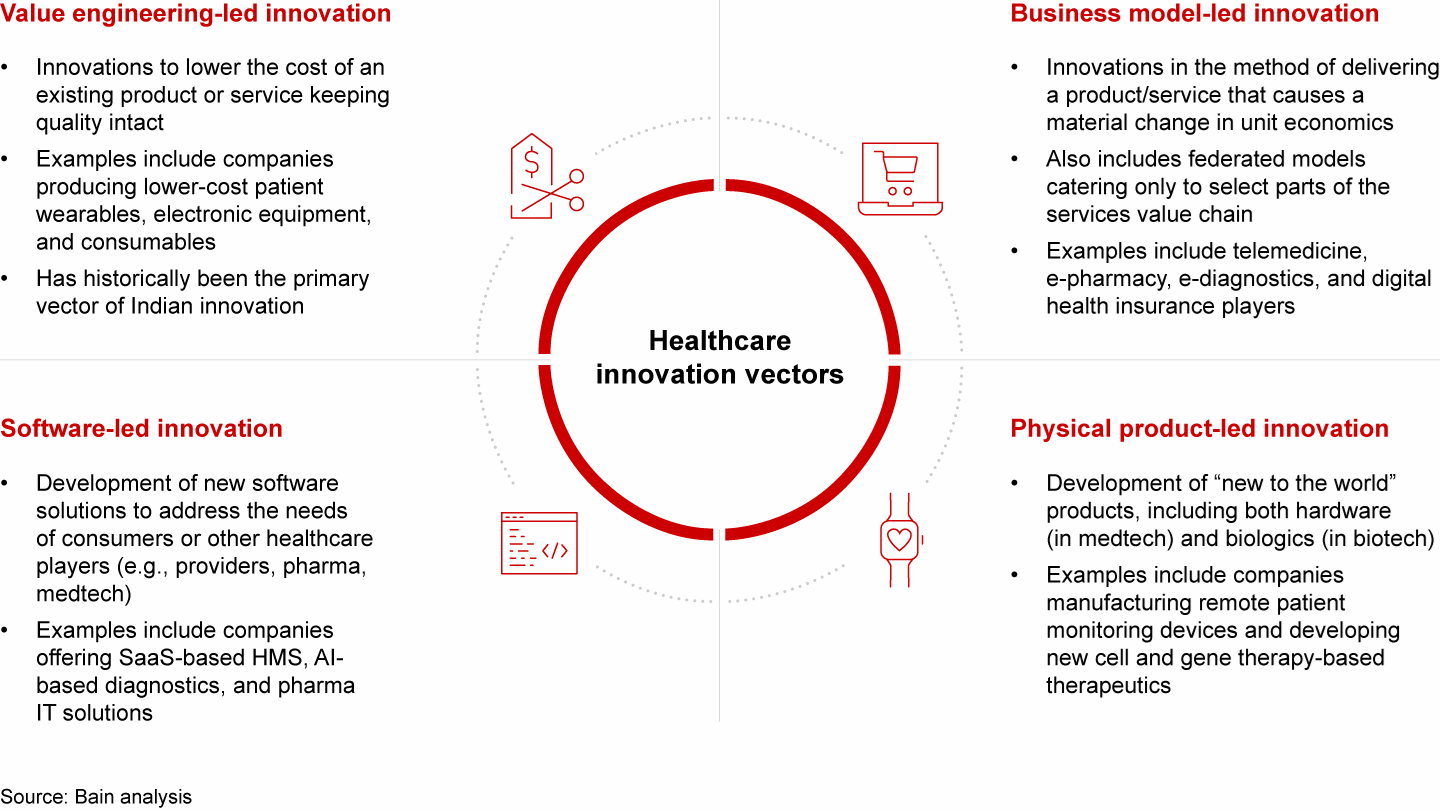
Innovations along these four vectors have resulted in multiple solutions across both consumer-facing and enterprise-facing segments of the healthcare market (see Figure 2a and Figure 2b).
Innovations along the four vectors have led to multiple consumer-facing solutions …

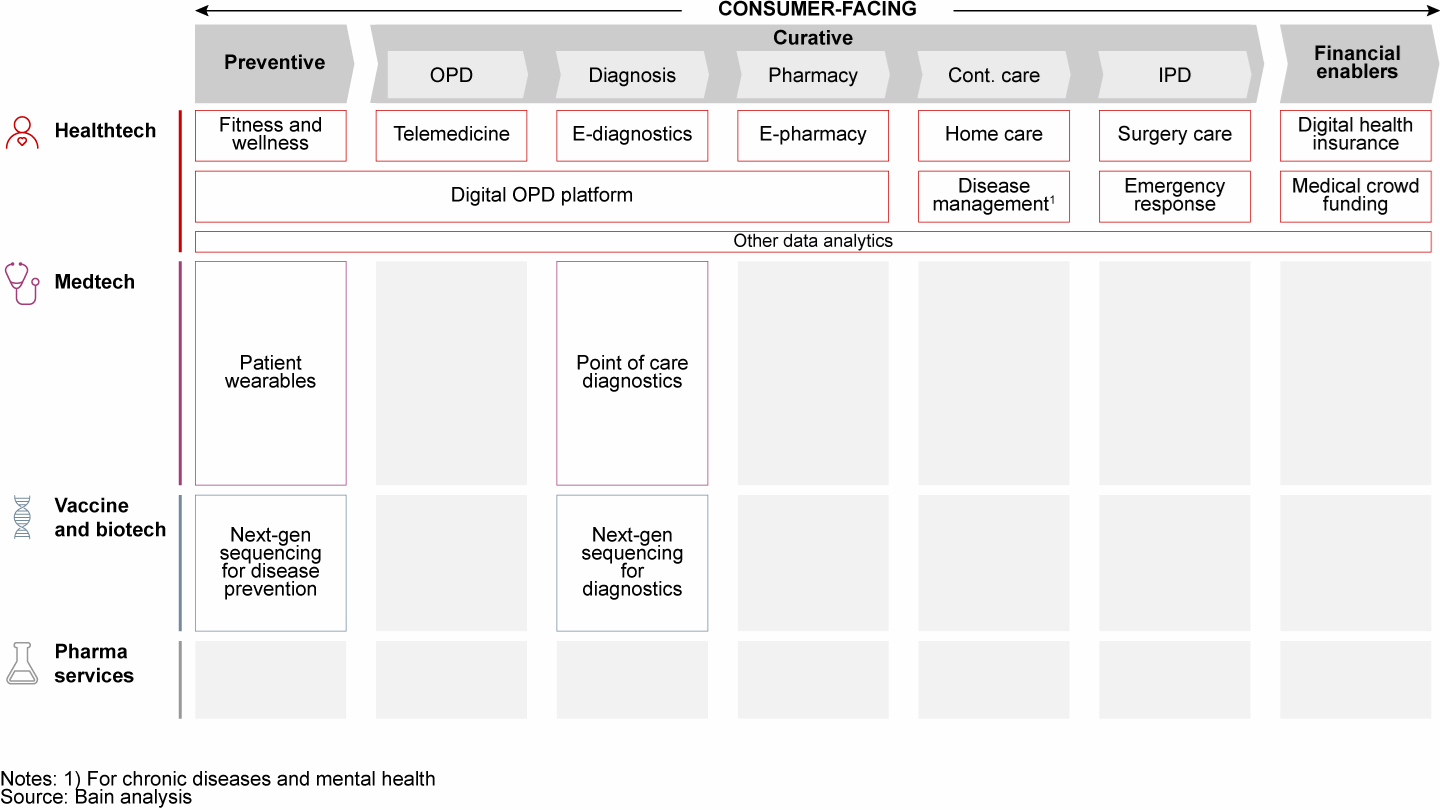
… as well as enterprise-facing solutions

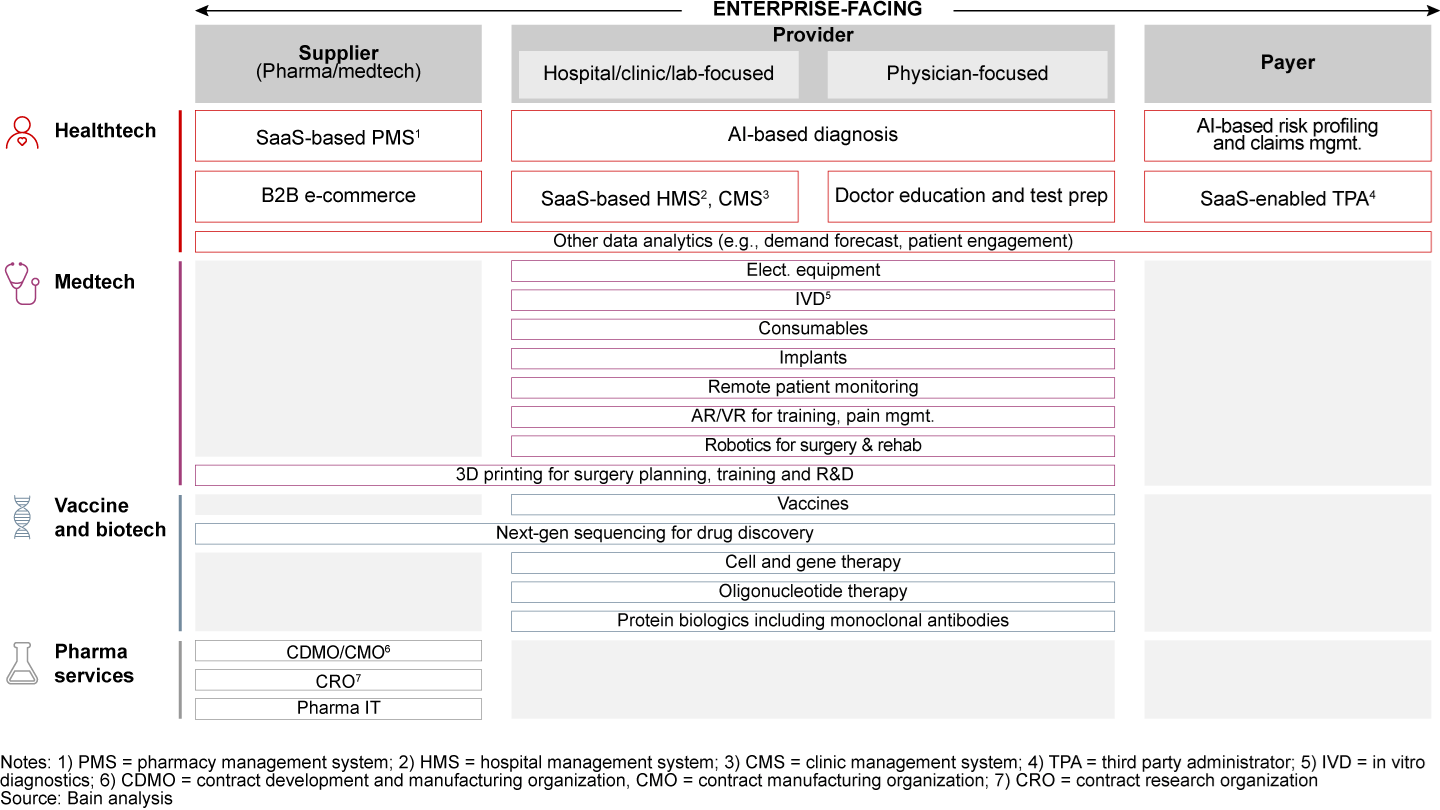
Healthcare innovation in India is currently an approximately $30 billion opportunity
The overall Indian healthcare market was about $180 billion in FY 2023 and is projected to grow at approximately 12% CAGR to reach roughly $320 billion by FY 2028 (see Figure 3).
The Indian healthcare market stood at approximately $180 billion in FY 2023, expected to reach about $320 billion by FY 2028

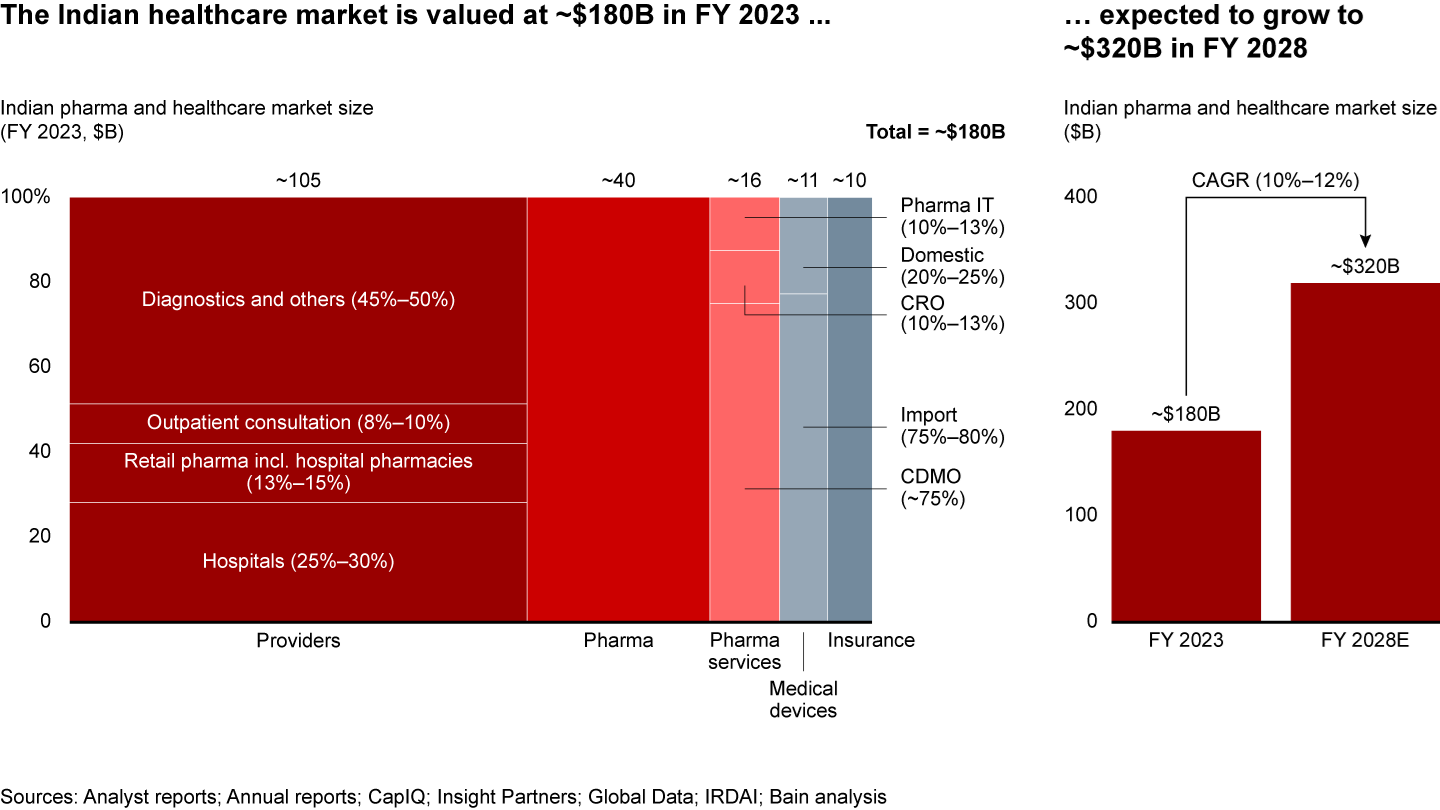
Within this overall market, healthcare innovation accounts for about 15%, or $30 billion (see Figure 4), of which 55% is export-led. Healthcare innovation has almost doubled over the last three years from a baseline of $17 billion in FY 2020.
Healthcare innovation was an approximately $30 billion market in FY 2023 and made up about 15% of the overall healthcare market

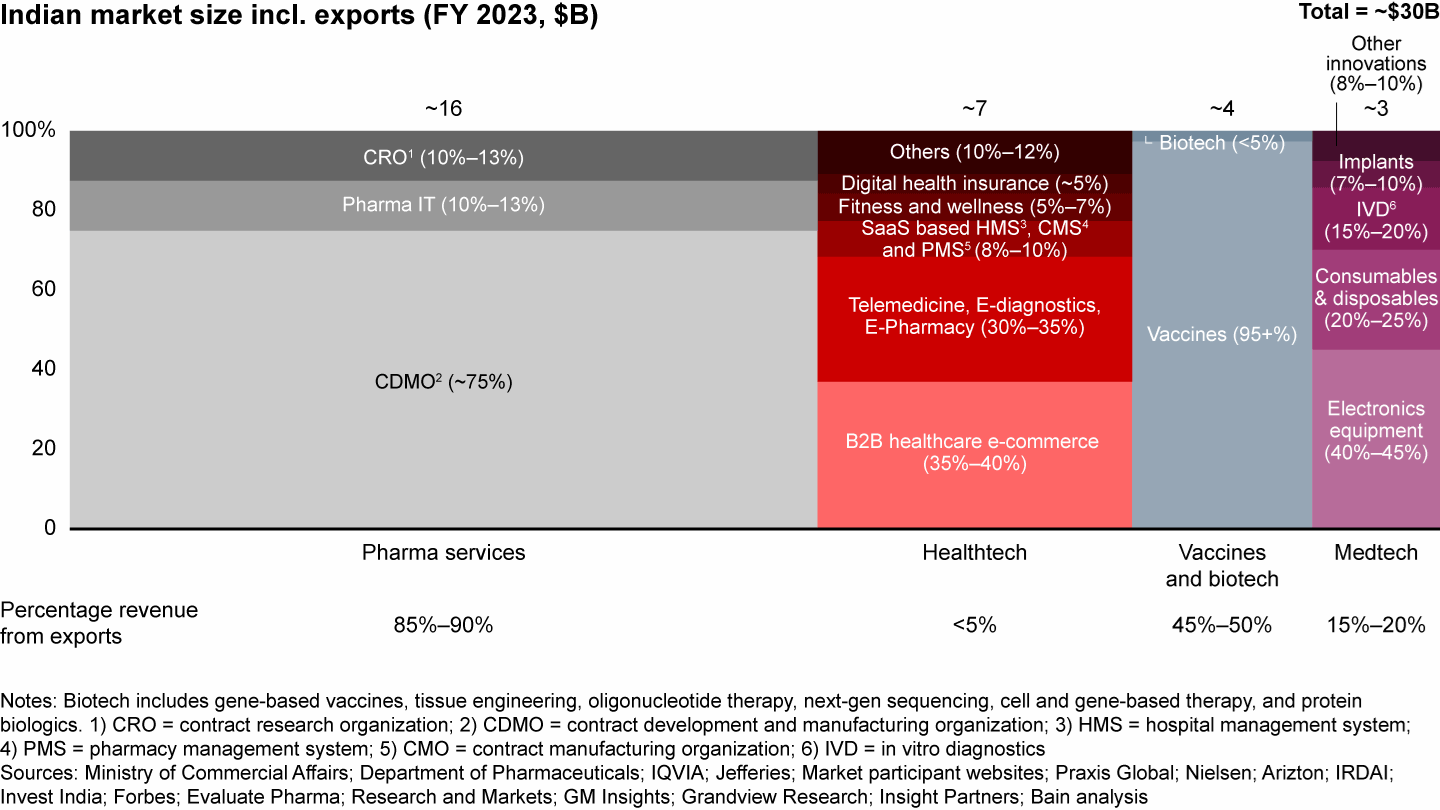
There are four key segments in the healthcare innovation space: Pharma services (contract development and manufacturing organization [CDMO], contract research organization [CRO], pharma IT), healthtech, vaccines and biotech, and medtech.
Pharma services, dominated by exports, account for approximately 50% of the healthcare innovation market
The Indian pharma services market was valued at about $16 billion in FY 2023, up from about $11 billion in FY 2020, with 85%–90% of revenue driven by exports. The CDMO segment saw the highest growth, driven by global supply chains shifting away from China and improvement in capacity, capability, and quality by Indian players. Pharma IT also showed robust growth, led by growing global price pressures and demand for omnichannel transformation.
Three key trends have impacted this segment over the last few years:
China + 1 strategy: India is currently the second largest CDMO player globally, after China, for small molecules. India’s market significance has grown markedly over the last three years, driven by Big Pharma’s movement away from China due to supply chain disruptions, global trade risks, and China’s prioritization of domestic markets. The presence of a higher number of US FDA-approved manufacturing plants in India compared to China, fewer FDA warnings for Indian manufacturing compared to Chinese counterparts, and the availability of a robust Indian workforce exceeding 1.8 million science graduates have further supported this shift.
Growing expertise of Indian players: Over the last few years, Indian players have gained expertise in chemical synthesis (especially for more complex products), injectables, and fermentation. Additionally, India’s growing technology expertise in areas like advanced analytics, AI/ML, and AR/VR has spurred more pharma services players to offer these solutions and encouraged the creation of technology “innovation hubs” in international pharma companies’ India-based global capability centers (GCCs).
Omnichannel imperative for global pharma companies: Pharma IT services started gaining significance, driven by the need for targeted healthcare professional engagement, customer centricity, and omnichannel transformation in commercial functions. Leading pharma companies like GSK and AstraZeneca have started strengthening their omni-channel presence and are looking to set up centralized omni-channel functions to drive economies of scale. Mankind Pharma has established a unified commerce platform to drive a seamless and scalable customer experience across digital channels.
Healthtech has witnessed strong growth since 2020, driven by Covid-19 tailwinds and enterprise efficiency imperatives
Healthtech accounted for roughly 25% of the healthcare innovation market in FY 2023, having more than doubled from about $3 billion in FY 2020 to about $7 billion in FY 2023. The healthtech market is split equally between consumer-facing solutions (like telemedicine, e-pharmacy, e-diagnostics, and wellness) and enterprise-facing solutions (like B2B e-commerce and SaaS-based hospital, clinic, and pharmacy management solutions).
Encompassing more than 10,000 start-ups, healthtech continues to be a hub of innovation in India. The Covid-19 pandemic provided a significant growth impetus for consumer-facing segments. Enterprise-facing segments also netted robust growth, primarily through acquisitions of unorganized peers and expansion of their geographic footprint.
The healthtech segment has been shaped primarily by three key trends in recent years:
Horizontal and vertical integration: As consumers mature in their use of digital health offerings, they increasingly seek convenience and a single touchpoint of care. Several healthtech players have begun efforts to streamline the consumer journey. As a result, “phygital” business models are growing. PharmEasy set up more than 80 pharmacies with plans to open up to 1,500 by FY 2025, while Redcliffe Lifetech set up at least 80 diagnostic labs and more than 2,000 collection centers by FY 2025. Companies are adopting horizontal and vertical integration strategies to broaden their offerings and improve margins. For example, MediBuddy has expanded beyond its initial offering of digital claims assistance to offer a comprehensive range of consumer health services.
Growing right-to-win in global markets: Healthtech players have started expanding into global markets to increase their addressable patient pool, especially for services with a limited willingness to pay in India. For example, Wysa, a generative-AI-based mental health platform, received FDA breakthrough device designation in FY 2023 and counts the UK and the US as its primary markets. Qure.ai, an AI-based radiology assistance solution (with 13 US FDA approvals), received funding from the UK government for its technology and approval to implement its solution across 25 NHS trusts.
Disruptive entrants: The segment witnessed consolidation over the last few years as large incumbents and digital natives acquired players in a bid to hasten their foray into digital health. Examples include Tata Digital’s acquisition of 1mg, Reliance Retail’s acquisition of Netmeds, and Flipkart’s acquisition of SastaSundar. These acquisitions have resulted in greater segment concentration, broader reach for scale players, and the emergence of newer templates of success.
The Indian vaccines segment continues to be a powerhouse on the global stage, while biotech has seen the emergence of new start-ups with innovative technologies and products
The vaccines and biotech market was valued at about $4 billion in FY 2023, accounting for around 15% of the innovation market. It has grown quickly, rising from about $1.2 billion in FY 2020—with roughly half this revenue surge driven by exports. India remains a vaccine powerhouse catering to around 60% of global vaccine demand.
Biotech start-ups are also starting to use new technologies like cell and gene therapy, oligonucleotide therapy, protein biologics, gene editing, and next-gen sequencing to develop innovative products with large potential markets. For example, Zumutor Biologics is developing natural-killer cell receptor monoclonal antibodies for cancer treatment, and Bugworks is developing novel anti-microbial therapies to combat drug resistance. While commercialization of these technologies is still in early stages, we are starting to see promising results. For example, ImmunoACT received marketing authorization for its CAR-T cell therapy in late 2023 and has started deploying it through a network of partner hospitals in the country.
Four key trends have shaped this market in the last few years:
Covid-19-based impetus for vaccines: Covid-19 pushed large pharma companies to accelerate efforts for innovation along new modalities and therapies. Zydus developed a plug-and-play, plasmid DNA platform which can be adapted to deal with virus mutations. Gennova developed an mRNA vaccine which got approval for use in India. This push also drove traditional Indian vaccine manufacturers like Serum Institute of India and Bharat Biotech to push their boundaries of innovation to stay relevant.
Accelerated approval routes: The US FDA introduced accelerated drug approval programs for critical drugs, therapies, and vaccines after the success of the Covid-19 vaccine development, resulting in quicker time to market for companies. This is expected to set a precedent for accelerated approval processes in other markets, benefiting vaccine and biotech players.
Rise of innovative funding constructs in biotech: Historically, long R&D cycles and high-risk binary outcomes resulted in limited funding inflow into biotech start-ups from traditional venture investors. However,innovative constructs for investments and exits (e.g., milestone-based outcomes) have emerged, mitigating investor risk and spurring greater investment in the space.
Entry of new investor classes in biotech: The biotech segment attracted growing interest from healthcare companies and family offices of promoters over the last few years. Notable investments include those made by Laurus Labs in ImmunoACT and by Apollo Hospitals in Immuneel Therapeutics.
Medtech players are moving past value engineering to build new-to-the-world products
Medtech in India is an approximately $11 billion market overall, dominated by imports, which account for 75% to 80% of the market. Indian medtech players accounted for about $2.5 billion in FY 2023, up from approximately $1.8 billion in FY 2020.
Four key trends have shaped this market in the last few years:
Shift from value engineering to innovative products: While Indian players have historically focused on value engineering, recent years have seen the development of innovative, new-to-the-world products in areas like devices (e.g., portable battery-based RT-PCR by Molbio Diagnostics) and stents (e.g., world’s first 100 µm fully biodegradable vascular stent by Meril Life). Players have also introduced targeted, fit-for-purpose products in niche diagnostic areas like breast cancer detection (e.g., AI-based breast cancer detection tool by Niramai).
Use of advanced hardware technologies: Indian companies are also increasingly building products using advanced hardware technologies such as robotics and 3D printing. For instance, Alfatek Systems developed an indigenous 3D bioprinter, which has been installed in more than 100 R&D labs in India, including in AIIMS Delhi.
Growing presence in global markets: Indian medtech is developing into an export powerhouse with low-cost and high-quality certified products to gain salience in global markets. For example, SigTuple, which developed an in vitro diagnostic device to automate manual microscopy, now counts Southeast Asia as another key market besides India. Similarly, SMT, the market leader in India for minimally invasive cardiovascular devices, has seen strong export growth, particularly driven by the European market.
Increasing regulatory scrutiny and pricing pressure: The Indian medical devices industry is witnessing tightening of regulatory frameworks and quality checks, along with pricing and trade margin caps by the National Pharmaceutical Pricing Authority in multiple categories (e.g., the price for drug-eluting stents is now capped at approximately $460). These pricing caps, coupled with a proliferation of domestic and regional players, especially in low-tech categories like consumables and stents, are also creating pricing pressure in the medtech industry.
Investor sentiment remained relatively stable with a shift in investment themes
Investments in healthcare innovation have typically ranged from $1.5 billion to $2 billion annually, with FY 2022 being an outlier year when deal value surged to approximately $4.2 billion, largely driven by investments in PharmEasy worth approximately $1.5 billion (see Figure 5).
Funding for healthcare innovation has been stable at around $1.5–$2 billion with FY 2022 being an outlier

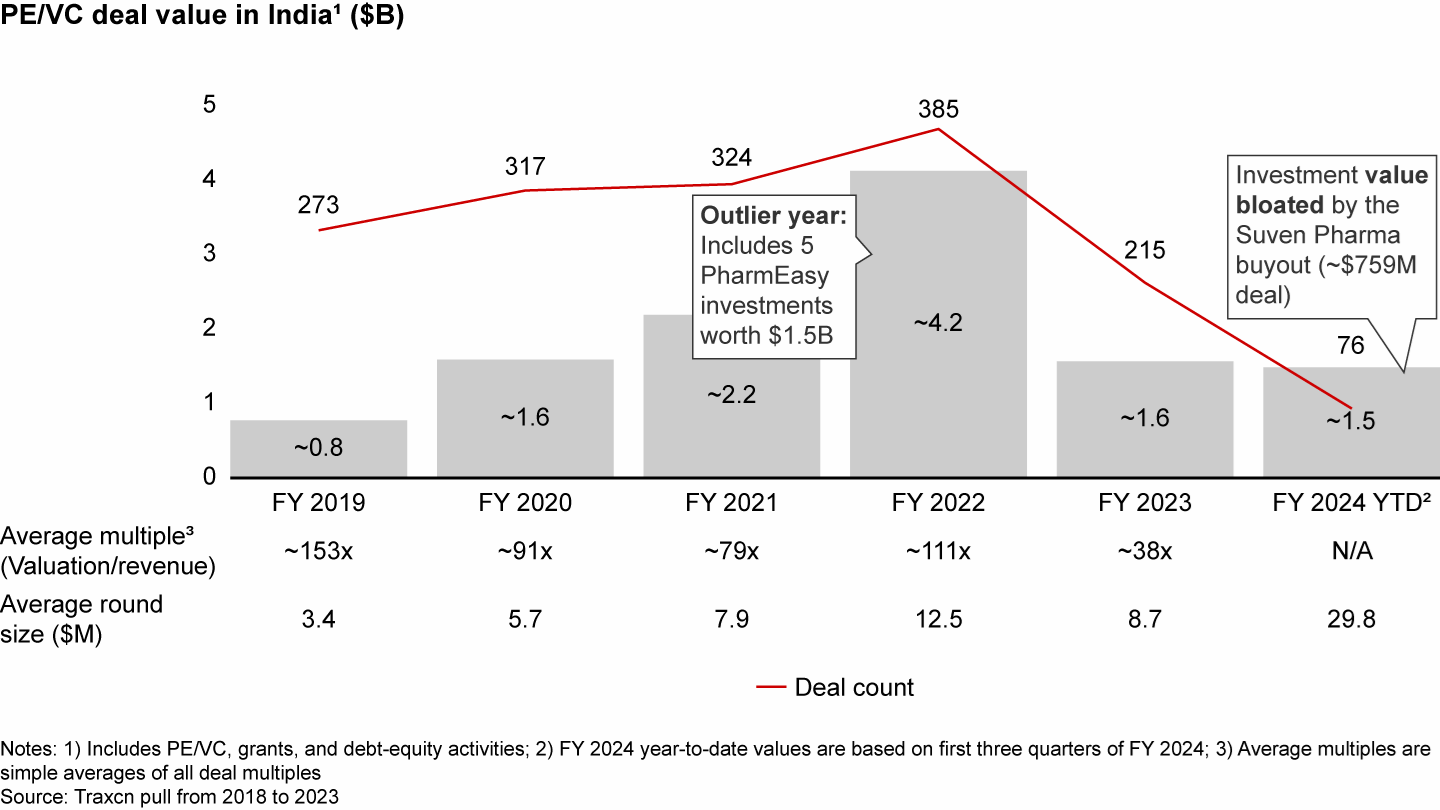
Investment activity remained constant across stages, while the focus on positive-unit economics increased
Investments have been stable across deal stages, with 80% to 90% of deal volume in seed and early- stage VC rounds (series A, B), 3% to 7% in late-stage VC rounds (series C and above), and less than 5% in late-stage PE and other deals. Healthtech consistently attracted interest, netting more than 55% of overall deal volume across the last few years. Some prominent investments in this space include online pharmacy player PharmEasy, which raised a cumulative funding of more than $2 billion across more than 10 rounds, and digital health and wellness player HealthifyMe, which raised a cumulative funding of more than $110 million across five rounds.
However, due to global macroeconomic uncertainty, investors are looking to place bets on business models that offer lower risk and higher positive-unit economics. Enterprise-facing segments solving operational efficiencies or supply chain constraints saw particular investor interest due to their potential for strong unit economics, high total addressable market, and robust market acceptance. For example, Medika-bazaar, a B2B e-commerce player, raised approximately $65 million in FY 2023, while clinical data analytics firm THB raised approximately $20 million in FY 2023.
Rising investor interest seen in pharma services
Pharma services firms accounted for roughly 35% and 55% of total funding flows in FY 2023 and FY 2024, respectively, up from 15% to 25% in earlier years. China + 1 tailwinds primarily drove this growth, as did the growing expertise of Indian players and increased cost focus by Big Pharma. While this increase has been dominated by a small number of large, late-stage investments (e.g., the approximately $760 million investment in Suven Pharma in FY 2024), India is also witnessing active investments in smaller companies (e.g., $12.5 million investment in GoApptiv in FY 2023 and $35 million investment in Doceree in FY 2024).
Investor appetite for medtech and biotech investments is starting to grow
Medtech and biotech have historically seen low levels of venture funding. Investor wariness has been driven by lengthy R&D and monetization cycles, the risk posed by binary outcomes, and the lack of deep technical expertise required to assess these businesses. However, these trends are starting to shift with the emergence of sector-focused funds, growing numbers of technologically savvy family offices, and the rise of new investment/exit constructs that address the constraint of long monetization cycles. Notable deals in this area include Sun Pharma’s investment in Agatsa, Cipla’s investment in Achira Labs, and Biological E’s investment in Eyestem.
Five key themes will shape the future of healthcare innovation in India
Consumerization of health, which saw an inflection due to Covid-19, continues to grow
Covid-19 accelerated Indian consumers’ focus on health, which was already on a steady rise driven by underlying secular income growth, rising internet penetration, digital payment systems, and demographic shifts leading to creation of a large pool of digital health users (roughly 500 million people have registered Ayushman Bharat Health Accounts). According to Bain’s Frontline of Healthcare survey, usage of digital health applications like e-pharmacy, telemedicine, and wellness services grew between 20% to 100% due to the pandemic, with consumers expecting their use to further increase by 5% to 10% annually. More than 70% of 250 Indian respondents agreed they expect convenience and quality care to manage their health proactively. These consumer demands will drive the continued growth of healthtech products and services to help consumers better and more conveniently manage their health and wellness.
Reconfiguration of global value chains will provide a boost to export-oriented segments
Globally, pharma companies are increasingly outsourcing discovery, development, and manufacturing in pursuit of lowered cost, capex, and working capital requirements coupled with reduced time to market. Bain research indicates that outsourcing currently accounts for 58% of the total spend on drug discovery, development, and manufacturing; this is expected to grow to 61% in 2027. The shift of focus away from China, coupled with the growing expertise of Indian players, will make India an attractive destination for outsourcing over the next few years.
India’s growing scientific and technological expertise will increase its importance as an innovation hub for Big Pharma
Twelve of the top twenty global pharma companies have established GCCs in India. While these units were originally set up as shared service centers with a tactical focus on support functions, several evolved into innovation hubs focused on deep R&D (pre-clinical, development, and clinical trials) and technological innovation (e.g., AI/ML, AR/VR, and advanced analytics). This trend will likely grow in the coming years, with Indian GCCs playing a key role in driving the innovation agenda.
Recent government policies could provide strong tailwinds, but implementation is key
Through its plans for a United Health Interface (UHI), digital registries, and electronic health records (EHR), the Ayushman Bharat Digital Mission (ABDM) could provide an impetus to digitization of health. The Ayushman Bharat PM-JAY scheme has a high potential to increase healthcare expenditure per capita in India. Together, initiatives outlined in the National Medical Device Policy, production-linked incentives (PLI), foreign direct investment (FDI), the creation of bulk drug parks, and the Policy on R&D and Innovation in Pharma-Medtech (PRIP) could further spur innovation and growth in India’s medtech and pharma services sectors. Policies such as establishing 65 bio-incubation centers across the country illustrate India’s commitment to fostering and boosting early-stage biotech R&D. While these are steps in the right direction, implementation and accountability will be key to ensuring a significant innovation unlock.
Increased advancements and usage of AI/ML technology will impact all segments of healthcare
Advances in AI foundational models are now demonstrating emergent capabilities rivaling those of humans in many areas: understanding visual, spoken, or written content; communicating and creating; reasoning and planning; time-to-output; and ability to act and use tools. These capabilities will lead to fundamental shifts across R&D, manufacturing, supply chain management, commercial operations, and healthcare delivery. The next few years are likely to witness the emergence of new solutions, companies, and profit pools driven by cutting-edge technology adoption.
The healthcare innovation opportunity is projected to reach approximately $60 billion by FY 2028
The healthcare innovation market is projected to grow to approximately $60 billion by FY 2028 (see Figure 6). Pharma services and healthtech will account for about 80% of this growth and remain the market’s largest segments in FY 2028.
The innovation market is projected to reach approximately $60 billion by FY 2028

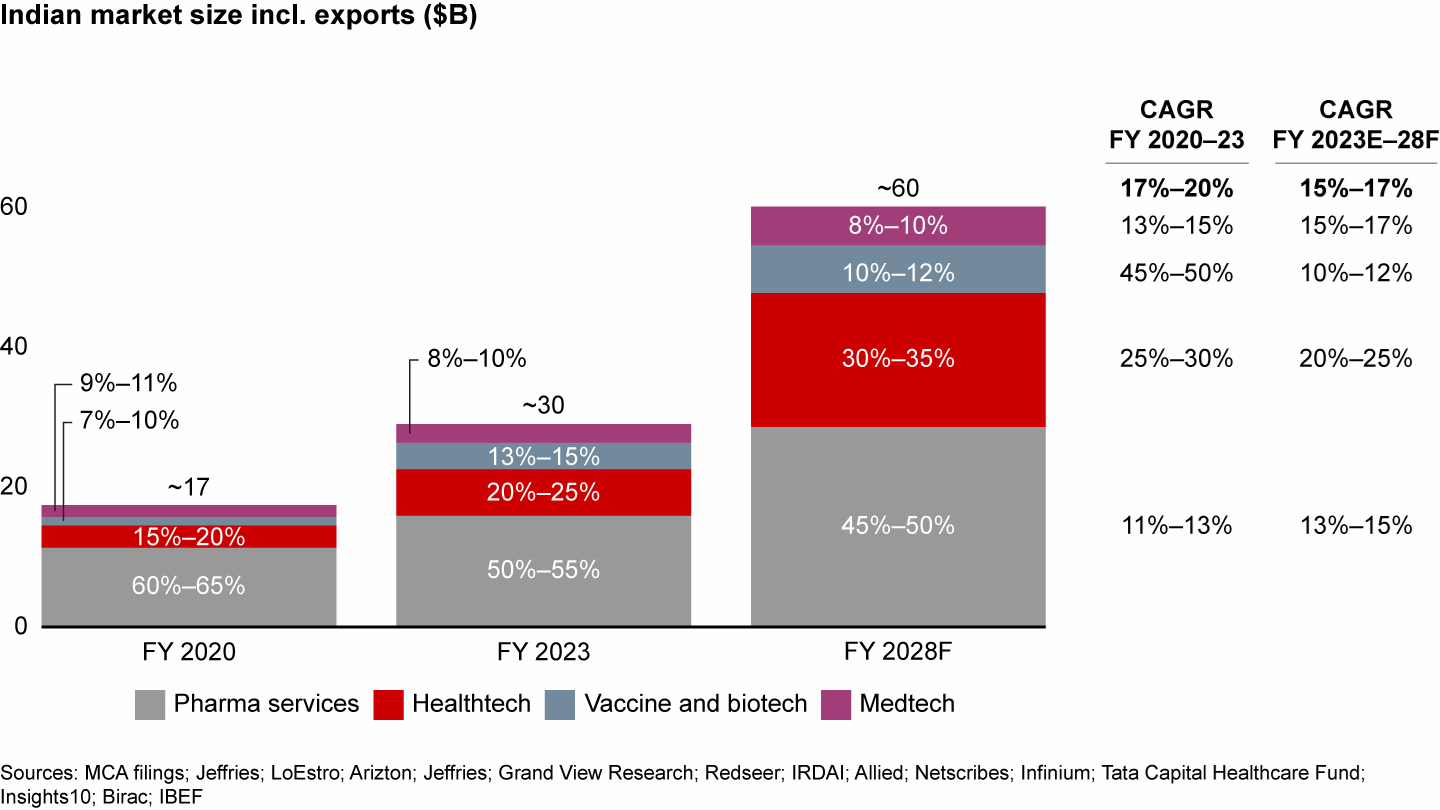
Certain structural changes in the nature of the market will accompany this growth:
- Consolidation across segments with rationalization of smaller underfunded businesses or those without a clear path to profitability
- Shift in profit pools toward companies that use technology to drive enterprise efficiencies versus those that rely on expensive customer acquisition, coupled with the emergence of a new set of companies leveraging AI/ML technology to deliver solutions
- Growing integration and partnerships across incumbents and digital-first players, leading to broader ecosystem plays aimed at streamlining the consumers’ healthcare journey and capturing a larger share of user wallets
- Increased relevance of global markets for healthtech, medtech, and biotech players to drive scale
- Unlock of growth in medtech and biotech driven by the rise of new investment constructs and underlying regulatory tailwinds
- Increasing relevance of Tier 2/3 markets for growth, resulting in an increase in access and affordability of health services for previously underserved populations
Key imperatives
Imperatives for insurgents
Given the strong focus on positive unit economics in the current investment climate, insurgents must identify efficient ways to acquire customers, drive operational efficiencies, and define a clear path to profitability. They also need to define and build defensible competitive moats, either through seamless customer experience (e.g., horizontal integration), superior business models (e.g., vertical integration), or differentiated technology (e.g., deep tech).
The active exploration of ecosystem partnerships and early adoption of advanced technology are other key imperatives. For healthtech players, ecosystem partnerships with incumbents or other innovators will be key to efficiently building a seamless consumer journey. Similarly, for medtech and biotech players, ecosystem partnerships to support development, distribution, and commercial operations are the key.
Additionally, it will be critical for players across segments to embrace new AI/ML technologies in a way that allows competitive differentiation while mitigating risk.
Imperatives for incumbents
Incumbents should define clear innovation goals rooted in company strategy and future industry outlook. They should also explore multiple buy-build-partnership avenues to achieve these goals: traditional M&A, corporate venture capital, partnerships, incubators or accelerators, and internal grassroots innovation. Driving disruptive innovation requires dedicated autonomous units with separate funding, a long-term investment mindset, and an aligned vision of risk appetite.
For payers and providers, building seamless omnichannel patient journeys will be critical while actively leveraging ecosystem partnerships. Key imperatives for pharma services, medtech, and vaccine and biotech players include active adoption of the latest technologies, including generative AI-enabled commercial and R&D operations, plus integrated solutions to build and support a robust data and analytics ecosystem.
Imperatives for investors
The current investment climate allows investors to invest in high-potential companies at reasonable valuations. Investors should look for opportunities with high disruption quotient, demonstrated execution potential, and scope to quickly consolidate or create an omnichannel model. Additionally, investors should explore segments like medtech and biotech, which have historically not been a focus but are now starting to see a confluence of growth factors. Risks of investing in these relatively more nascent sectors can be mitigated through innovative investment and exit constructs. Investors should also actively evaluate the pharma services segment, which will likely witness robust growth in the next five years. While vaccine segment growth will slow compared to the Covid-19-driven high of the last three years, it remains an attractive investment space with high profitability and limited development risk.
Conclusion
While the last few years have seen the growth of innovation across segments, addressing key ecosystem issues will be critical to unlock the next wave of growth. Areas requiring attention include streamlining and accelerating regulatory approval processes for medtech and biotech, robust implementation of recent government policies, and bringing all healthtech players into regulatorily defined “healthcare” to allow benefits and quality controls to be broadly applied to the sector. Forums enabling greater dialogue between healthcare incumbents and insurgents will also be critical to providing healthcare players with a unified voice, to ensure active collaboration in improving health outcomes. We are hopeful that a collective effort on these fronts will help unlock the full potential of healthcare innovation in India.

About HealthQuad
HealthQuad is India’s leading healthcare transformation fund backing innovative models to radically improve healthcare access, affordability, and quality of care by leveraging technology. HealthQuad is a thought leader and sectoral expert in healthcare and has delivered strong financial returns to its investors while also creating transformative social impact. HealthQuad offers a distinctive blend of clinical, operating and investing experience, along with access to a rich healthcare ecosystem across multiple geographies, which helps in deal sourcing, diligence, and portfolio value creation. HealthQuad’s portfolio companies have served the healthcare needs of more than 10 million lower income Indian patients and improved access to quality healthcare in Tier 2 and Tier 3 towns and villages of India while also solving for global healthcare problems. The fund’s investment philosophy is to invest in disruptive companies with a proven revenue model and a large market potential, backed by strong management teams.